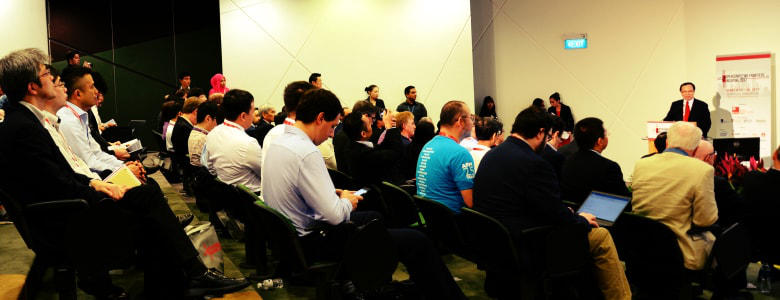Beyond the frontiers of Supercomputing

What do you get when you put the world’s foremost supercomputing experts together in the same room?
Plenty of opportunities for dialogue, collaboration and exchange of new ideas.
Approximately 450 participants from 12 countries attended Supercomputing Frontiers 2017 (SCF2017), the National Supercomputing Centre (NSCC) Singapore’s third annual international conference held from 13-16 March at the Biopolis.
NSCC Director and SCF2017 Organising Chairman Professor Tan Tin Wee said that the conference would allow the eclectic crowd to share ideas which could take the field to the next level — exascale supercomputing, referring to computers capable of one billion billion [1018] calculations per second.
In his speech, guest of honour and NSCC Steering Committee Chairman Mr Peter Ho said that supercomputing capabilities are now considered critical for countries to remain competitive in almost every sector of the economy, including aerospace, biomedical sciences, electronics, finance, healthcare, and marine and offshore engineering.
NSCC’s task, he said, is thus to build the computational infrastructure needed to support Singapore’s universities, research institutes and industry.
Supercomputing for Singapore’s future
In December 2016, with the launch of NSCC’s Advanced Supercomputer for Petascale Innovation Research and Enterprise (ASPIRE 1), Singapore finally entered the petascale league (one million billion [1015] calculations per second).
“ASPIRE 1 will underpin the national research infrastructure,” said Mr Ho. “It’s the first, we hope, in a series of supercomputers that will form the foundation of Singapore’s push to compete in the digital economy.”
At its launch, ASPIRE 1 was already operating at close to maximum capacity — an encouraging start, said Mr Ho. “It’s an indication of future demand and the strong promise of supercomputing in Singapore.”
The supercomputer is also connected via InfiniBand — a highly efficient communications technology — to supercomputing centres around the world, including in Australia, Japan, Europe and North America, thus facilitating collaborations.
Despite this progress, Singapore’s supercomputing journey is just beginning.
“Singapore is only at the start of developing and implementing a high-performance computing strategic roadmap,” said Mr Ho. “For NSCC to realise the vision of catalysing supercomputing in Singapore, its team will have to bootstrap onto the knowledge and experience of others.”
The Who’s Who of Supercomputing
SCF 2017, he said, would present many opportunities for this. “I hope you will all learn something about how we can position ourselves, not just in Singapore but in our respective countries as well, to exploit the power of supercomputing to improve economic competitiveness, and more importantly, the lives of our people,” added Mr Ho.
At the conference, experts from academia and industry spoke on topics such as exascale supercomputing, new processor architectures, quantum and post-quantum supercomputing approaches, and the integration of computing hardware, storage and networking.
SCF2017 also featured a star-studded line-up of keynote speakers, and here are just some of the highlights: Professor Gordon Bell (of Bell’s Law fame) gave his take on three decades of the Gordon Bell Prize, widely regarded as the Nobel prize of supercomputing, while Dr Alessandro Curioni of IBM spoke about the power of cognitive computing.
In addition, Dr Thom Dunning of the Northwest Institute for Advanced Computing talked about technologies aimed at making the leap to exascale computing, and Dr Haohuan Fu, Director of the National Supercomputing Centre in Wuxi, China, spoke about the Sunway TaihuLight, currently the world’s fastest supercomputer.
Singapore’s Supercomputing champions
Yet another conference highlight was the launch of the inaugural SCF/NSCC awards, which recognise excellence in high-performance computing (HPC) in Singapore, as well as outstanding research and commercial efforts that make use of ASPIRE 1’s computational capabilities.
The winners received their awards at the opening ceremony from Mr Ho.
Among the winners was Mr Lim Chuan Poh, Chairman of the Agency for Science, Technology and Research (A*STAR), who received the Supercomputing Frontiers Singapore Distinguished Service Award for his leadership in guiding Singapore into petascale computing.
Dr Raj Thampuran, ASTAR’s managing director, received the Supercomputing Frontiers Singapore Visionary Award for his role in conceiving the ASTAR Computational Resource Centre (A*CRC), and for his leadership of the Institute of High Performance Computing (IHPC).
In addition, A*STAR’s Data Storage Institute (DSI) picked up the NSCC Outstanding HPC Scientific Award for its use of supercomputing resources to simulate the magnetic properties of nanomaterials. The NSCC Outstanding HPC Industry Application Award went to Keppel Offshore and Marine Technology Centre (KOMTech) for its use of supercomputing in various computational fluid dynamics analyses.
“The winners come from industry, research and academia, including some educators who are nurturing bright young students in schools,” said Mr Ho.
“I congratulate all of them because they are part of the foundation on which we will build Singapore’s future supercomputing capabilities.”
https://www.tech.gov.sg/media/technews/beyond-the-frontiers-of-supercomputing
